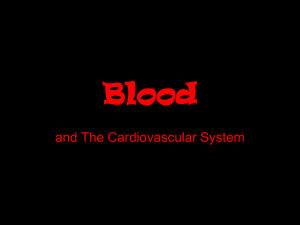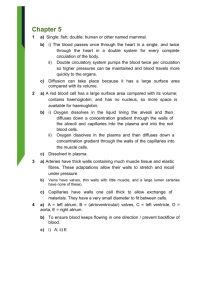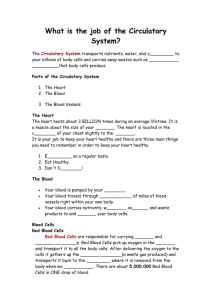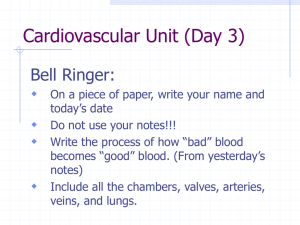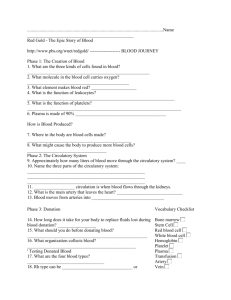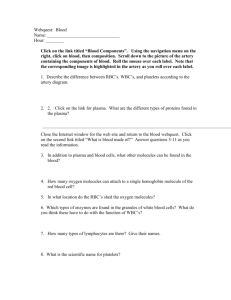Anatomy_and_Physiology_files/Blood and cardio
advertisement
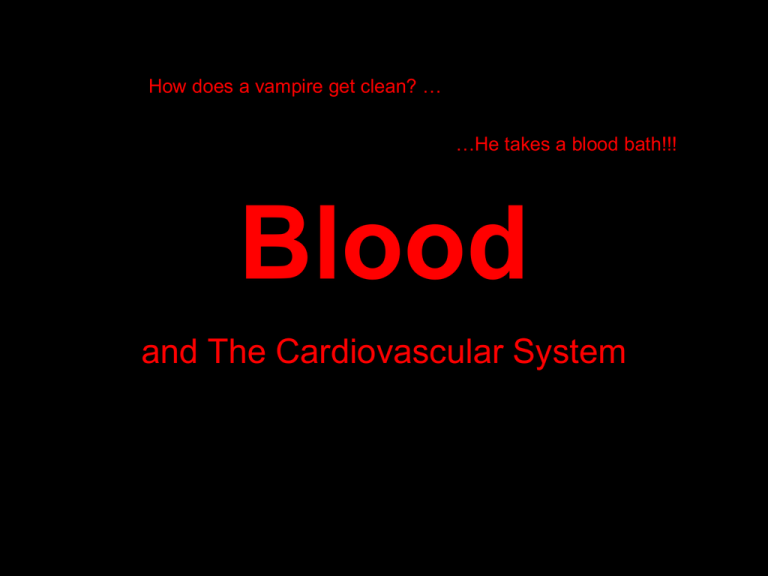
How does a vampire get clean? … …He takes a blood bath!!! Blood and The Cardiovascular System Volume and Composition Average human adult has a blood volume of about 5.3 liters. Varies with size and sex of individual Sample of blood = 45% cells by volume – called Hematocrit (HCT) or Packed Cell Volume (PCV) Types of CellsRed Blood Cells White Blood Cells Platelets Volume and Composition Other 55% is a clear, straw colored liquid called plasma. Plasma components: Water Proteins Amino Acids Nutrients Electrolytes Wastes Blood Where does the color come from? Hemoglobin True or false? Oxygenated blood is red, unoxygenated blood is blue. FALSE! Oxygenated blood = bright red Unoxygenated = deep dark red (maroonish) DQ - Why do blood vessels look blue? Red Blood Cells Also called Erythrocytes Primary function – transport gases to and from cells No Nucleus – Why? Biconcave Shape –Thin in the middle and thick on the outside. Why might these be shaped in this way? Reason #1 – Increases surface area, assisting in transportation of gases Reason #2 - places the membrane closer to oxygen-carrying hemoglobin in the cell. Reason #3 – Shape allows it to squeeze through the tiny capillaries. Erythrocytes What is hemoglobin? An iron based protein in red blood cells that transports oxygen and carbon dioxide. A single RBC can contain over 250 million molecules Each molecule can bind 4 oxygen molecules White Blood Cells Also known as Leukocytes Primary Function = fight disease and infection Why would your WBC count increase when you are sick? Leukocytosis - elevated WBC count Leukopenia - abnormally low WBC count Leukocytes 5 Types (names, amount in mm3, function) Neutrophils (3000-7000) - phagocytize small particles Eosinophils (100-400) - kill parasites, controls inflammation Basophils (20-50) - release heparin and histamine Lymphocytes (1500-3000) - provides immunity, fights tumors Monocytes (100-700) - phagocytize large particles Platelets Also called Thrombocytes Not necessarily Red Blood Cell fragments Arise from Megakaryocytes These fragment, releasing small sections into cytoplasm Each platelet: ~ half the size of a RBC Lack a nucleus Function in the formation of blood clots Plasma 92% Water Functions 1. Transport materials (such as?) 2. Regulate Fluid and electrolyte levels 3. Regulate pH Components Plasma proteins Nutrients and Gases Plasma Electrolytes Plasma Proteins 3 Types Albumins Smallest in Size, make up 60% of volume Function – Osmotic Pressure Why are so many needed? Globulins Alpha and Beta – transport lipids and vitamins Gamma – are a type of antibody Fibrinogen Least common plasma protein (4%) Function – Blood Coagulation Nutrients and Gases Includes amino acids, simple sugars, and lipids Where do these nutrients come from? How are lipids (not water soluble) able to be in the plasma? Lipoproteins Low density Lipoproteins High Density Lipoproteins Which one is good, which is bad? How do they have different densities? Plasma Electrolytes Plasma Electrolytes Include: Sodium, Potassium, Calcium, Chloride, and others Where do they come from? Large intestine Electrolyte Purposes: 1. Maintain Osmotic Pressure 2. Supply tissues with electrolytes when needed 3. Regulate pH Blood Drop Activity • As a class, we will be a blood drop, you will be assigned a specific part of the blood drop. • It will be your job to describe your part without mentioning what you are. • We will have a class riddle session to guess the part of blood that each person is. Production of a Blood Cell • Occurs in the red bone marrow • Can be triggered by different things – Megakaryocytes – tissue damage – Leukocytes – foreign invaders – Erythrocytes – oxygen levels and erythropoietin • Low oxygen = more erythropoietin (more production) • High oxygen = less erythropoietin (less production) • All types start out as a Hemocytoblast (blood stem cell) • Then differentiates into: – Lymphoid cells, which become lymphocytes – Myeloid cell, which will become a leukocyte, erythrocyte or thrombocyte Blood Clotting • Hemostasis – stoppage of bleeding • Done in three ways • 1. Platelet plug – What is this? • Platelets typically repelled by walls of blood vessel • But when wall is broken, collagen is exposed and the platelets are attracted to and stick to that. • Platelets then release chemicals to attract more platelets – This keeps building, creates a dam. Hemostasis • Platelets also release serotonin, this causes: • 2. Vasoconstriction – What is this? • Muscular layers in the walls of the vessel contract – Can sometimes close the vessel completely – May only last for a few minutes Hemostasis • The damaged tissue will release a chemical that starts the process of: • 3. Blood Coagulation – What is this? • Formation of a blood clot • This is the most effective, but takes the most time. • A chain of events must occur for this to happen – Prothrombin to thrombin – Fibrinogen to Fibrin – Fibrin “net” • How would anticoagulants affect this? Hemostasis • What must happen? Blood Types • On our RBCs we have antigens – Identifiers to let our body know our cells • Our blood also contains antibodies against other blood types – This will attack blood types with other antigens (ex. Type A has anti-B antigens and will attack type B cells) – This will cause agglutination • This is why blood type is so important during blood transfusions. Blood Types Blood type Antigens Antibodies Possible Donor types A A Anti-B A O B B Anti-A B O AB A and B None AB, A, B, O O None Both O O = Universal Donor AB = Universal Recipient • There are other factors (Rh factor) that play a role too but we are not going to worry about those Blood Types • The genes for A and B are codominant, the genes for type O are recessive. • This means that there are four possible blood types • And 6 possible genotypes •This is useful in eliminating potential fathers in paternity cases Blood Type Possible Genotypes A AA AO B BB BO AB AB O OO Parts of the heart • External Anatomy • Average - 14 cm long (base to apex)x 9 cm wide and 280 g • Covered with the Pericardium – A sac like structure filled with fluid surrounding the heart. • Why would this be here? • Used mainly for protection • Walls of the heart are thick and muscular – Why would this be? Parts of the heart • Internal Anatomy • 4 Chambers • Atria – Blood enters heart here – From where? • Body or the lungs • Ventricles – Blood leaves heart from here – The walls are much thicker around the ventricles, why Parts of the heart • Atrioventricular valves – What are they going to do? • Separate the atria and ventricles • They prevent blood from flowing the wrong direction • Tricuspid valve – between right atrium and right ventricle • Mitral valve – between left atrium and left ventricle • Also valves at the beginning of pulmonary veins and aorta Parts of the Heart • What would be a problem if the valves would not working correctly? – AKA Heart murmur • Heart becomes inefficient – can cause complications *****Sound of the heart beat comes***** from the valves closing. Cardiac Cycle • AKA Heartbeat • Atrial walls contract while ventricular walls relax • Ventricular walls contract while atrial walls relax • What valves would close during each of these processes? • Atrial contraction = pulmonary and aorta • Ventricular contraction = Mitral and tricuspid Path of Blood • • • • • • • • • • Right atrium Right ventricle pulmonary artery lungs pulmonary vein left atrium left ventricle aorta body vena cava right atrium Electrocardiogram (ECG/EKG) • Records electric impulses in the heart – Where do these come from? • 3 parts • P wave – atrial contraction • QRS complex – ventricular contraction • T wave – ventricular relax. Blood Vessels • • • • • 3 types Arteries Veins Capillaries All of these provide a closed system for blood to continuously flow through – But each are structurally and functionally different. Blood Vessels • Arteries • Carry blood away from the heart at high pressures • Characteristics of the walls: – Strong – Thick – Elastic • Why would the walls have these characteristics? Blood Vessels • • • • Veins Designed to carry blood back to the heart. Run parallel to arteries Wall is similar in structure to arteries, but muscular layer is less developed. – Wall is thinner, weaker, and less elastic Blood Vessels • Capillaries • Smallest of blood vessels – Some are so small that only a single RBC can make it through at a time • Have extremely thin walls • Why would they have such thin walls? • This is the point where gases and nutrients are exchanged. Blood Pressure • Measures amount of pressure on large arteries • Two numbers (i.e. 120/70) • First number is systolic pressure – Amount of pressure when heart is contracting • Second number is diastolic pressure – Amount of pressure when heart is relaxed • Why is high or low blood pressure bad?
